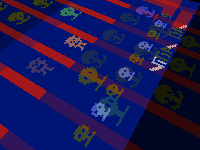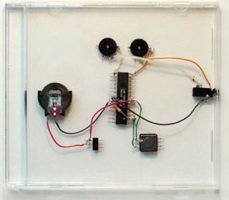The Null Device
Posts matching tags 'digital art'
2008/2/26
Two artists have created a device for manipulating fonts as one would synthesiser sounds. The Meek FM Typographic Synthesizer consists of a box of synth-like knobs connected to a Mac running software which allows the user to tweak aspects of a font using the knobs. (The font is stored in a higher-level representation, consisting of strokes, though it's said to be able to import standard PostScript fonts.) There's a video of it in use here.
2006/3/24
This is fairly nifty; a piece of software that divides a library of music videos into segments, listens for incoming sound, and plays the segments matching the sound the most closely. It's implemented using C++, Python and Pd, and will be released soon. Until then, you can watch the video, which explains it and demonstrates, playing back beatboxing as disjointed fragments from a MC Hammer video.
(via Music Thing) ¶ 0
2006/2/2
 Some hackers have has wired up an Atari 2600 emulator to Max/MSP/Jitter, ending up with a virtual Atari 2600 whose circuitry can be manipulated in lots of ways, creating weird and nifty visual effects:
Some hackers have has wired up an Atari 2600 emulator to Max/MSP/Jitter, ending up with a virtual Atari 2600 whose circuitry can be manipulated in lots of ways, creating weird and nifty visual effects:
The pixels rendered by the Atari 2600 emulator can now be treated as matrix data by Jitter. So, the game screen can be moved about in 3D space, stretched, and mapped to various types of surfaces (a sphere, for example).
Embedded within the Max/MSP programming environment, these manipulation parameters can be changed in relation to a signal, directly tied to music played through MSP.
It also means that a nearly unlimited number of manipulations can be done at the emulation level. Memory accesses can be visualized (including both RAM and ROM), colors manipulated, and synchronization signals tweaked.Of course, it is only usable if you have Max/MSP and Jitter (which cost a lot of money); though perhaps someone will do something like this for Pd?
2005/11/28
Nifty objet d'art of the day: the Pong clock:
It's an embedded computer with an LCD display screen, which plays a perpetual game of Pong, with one round per minute. The right-hand side wins once a minute, except on the hour, when the left-hand side wins (and the right's score is reset); hence, the score displays the current time. Clocks go on sale next year, though there will be a downloadable screensaver soon.
In a sense, this seems to be the computer-age equivalent of those mechanical clocks from centuries past, in which tiny figures promenaded around illustrating the time of day.
(I wonder what it's implemented on. If the device contains, say, a Mac mini or an entire Linux system and X server, it would seem somewhat decadent.)
(via bOING bOING) ¶ 4
2005/8/31
 This is pretty nifty: an artist has devised a device which fits into a CD jewel case and makes minimalist glitch electronica; the device is meant to fit into the standard album-based music distribution infrastructure, and to be purchased in shops; it will be released by a label named Cantaloupe.
This is pretty nifty: an artist has devised a device which fits into a CD jewel case and makes minimalist glitch electronica; the device is meant to fit into the standard album-based music distribution infrastructure, and to be purchased in shops; it will be released by a label named Cantaloupe.
The device looks somewhat minimal, and leaves a fair amount of space in the case; I imagine it could be expanded to less-minimal implementations. I imagine it wouldn't be too hard, in theory, to implement a sample-based music player (of the tracker/chip-tune variety) in that form factor, and provide it with enough algorithmic-composition logic to semi-randomly reconstitute/transpose/harmonise beats, basslines, chords and melodies into something resembling music.
(via bOING bOING) ¶ 0
2005/5/11
A tutorial on how to make isometric pixel art, à la the pixelicious Eboy.com. It's pitched at beginners, though has some useful hints. From what I gathered, Eboy's system is somewhat more sophisticated, with modular libraries of elements (buildings, street scenes and so on) that they can plug together, and possibly some sort of Common Lisp-based compositing engine, but this should work.
(I was thinking that someone should do an Eboy-style streetscape of Brunswick Street. Perhaps, once I figure out the forking-into-infinite-numbers-of-parallel-universes trick, I'll do it.)
2005/3/26
This computer game looks pretty nifty; photorealistic backgrounds of decaying buildings and rusty machinery and surrealistic cartoon characters. Unfortunately, it seems to be available only in Russia. (via Urban Decay)
2004/12/16
I went along to Dorkbot tonight, which was fun.
It started off with Mike Harrison's demonstration of "The Dreaded Destruct-O-Tron"; basically, a box with a huge capacitor that can be connected to various things, including an induction coil, and, when discharged, does evil things to anything metallic in close proximity to it. Harrison demonstrated it crushing soft-drink cans, launching hard disk platters at 300MPH, and, to popular applause, destroying a few copies of the recent Band Aid single. He also had a DVD of footage taken with a high-speed camera (at thousands of frames per second) of what happens to the hapless objects in question.
The "Exploring the Libido with an Analogue Computer" segment was a bit of comedy, somewhere between Benny Hill and Look Around You, in which a balding scientist type used an electromechanical computing device (an arrangement of motors and gears from a 1960s-vintage flight simulator) as a model of his sex drive, and afterwards, proceeded to demonstrate a spark generator connected to a 1980s portable computer programmed to detect raspberry-like noises, as a uniquely British answer to high-tech Japanese toilets. And yes, it's every bit as puerile as it sounds.
Possibly the most interesting part of the evening was Aymeric Mansoux's demonstration of his experiments with Pd; he basically had videos of Pd patches which gathered data (such as traceroutes to hosts or web server loads) and converted them into pretty good Autechre-esque music, along with visuals which wouldn't look amiss on a Warp DVD. Amusingly enough, the traceroute to www.microsoft.com looked and sounded rather dark and ominous.
The "Dorkestra", which consisted of people making noises was a bit hit-and-miss, being much like the What Is Music? festival in Melbourne. One guy was doing "optical analogue synthesis" with cooling fans and LEDs, which sounds impressive, except that the only sounds he seemed to make sounded somewhere between air-raid sirens and circular saws. Had he been able to play a tune, I would have been impressed.
There was also a raffle with free entry, largely to get rid of two BBC Micros. I didn't win either of them; I'm undecided as to whether that's a good or bad thing.
2004/11/18
Last night, I went to Dorkbot). It was a bit of a mixed bag; the presentation on London Free Map (a sort of geospatial Wikipedia, consisting of people with GPS units walking the lengths of streets to build up a GFDL/CC-licensed map of London and break the Ordnance Survey monopoly; connected with OpenStreetMap) was interesting, as were some of the "minidorks", including one by a chap who put a Wacom tablet on a guitar-like mount and used it to make noise with Max/MSP, and one by an American who built a 3D voxel display for Burning Man, using 729 microcontrollers, RGB LEDs and ping-pong balls, and an Ethernet printer server to control them). Others left a bit to be desired; the architecture student who started his with footage of the World Trade Center attack and went on to talk about the acoustics of spaces, sticking microphones into his mouth and filling latex balls with white noise, seemed a bit on the random side, while the presentation about the possibility of a bicycle that folds into an umbrella-sized package had little more than hastily-made Microsoft Paint drawings to it. There was also an intriguing-looking installation on the table, consisting of a brain-shaped set of neon tubes, a red vintage telephone and a Radio Shack speaker box, though the person operating it couldn't make it, and attempts to demonstrate it over the phone proved inconclusive (all it did was flicker, and the mobile phone interference drowned out what the guy at the other end was saying).
2004/7/14
The worlds of modern art and classic video games meet in Pac-Mondrian, which is just what it sounds like. They have a Java version of the game that works in browsers, and are constructing an actual Pac-Mondrian machine for installation in galleries.
2003/8/25
The LJ Times, a generative art hack which populates a newspaper-style page with random LiveJournal entries and Associated Press photographs. Quite amusing.
(Hmmm... the LiveJournal XML feeds offer a veritable cornucopia, or perhaps an Augean stable, of postings, most of them all but meaningless to people who don't know the poster, and thus functionally indistinguishable from computer-generated text or cut-up art. (The blogosphere at large can be said to have similar properties, though not all of it is in one convenient location.) I'm surprised more artists haven't harnessed these founts of commentary to power generative-art installations.)
Excellent news. SuperCollider, the rather Smalltalk-like audio synthesis programming language for the Macintosh, is now Free Software; it is being rewritten for MacOS X and Linux and released under the GPL. I played around with the MacOS 9 version of it a while back and it was a fun thing to play with. Not as visual as Pd/MAX, but more comfortable for those used to programming, and syntactically a very nice language.
2002/4/16
High-tech musical toys from the MIT Media Lab allow children to compose music without learning musical theory. The Toy Symphony site is here. How long, I wonder, until a future generation of ravers/indie kids pick up on these and start using them on records?
2002/3/20
